

Information Technology (IT) Pioneers
Retirees and former employees of Unisys, Lockheed Martin, and their heritage companies
They Flew, Chapter 20
1. Flying Programmers Introduction
This page was inspired by an email from Jim 'Rapp' Rapinac: "Please consider adding Oscar's story to the ASW article. [August 2013 'Article for the Month' commemorated 50 years of airborne systems.]
 Oscar reported to Bob Blixt and was a software/systems team leader on Naval Air Development Center
(NADC) Anti-Submarine Warefare (ASW) Mod 1 Program.
He suffered a severe stroke and was on life support for a few days until the family agreed to remove the life support system.
His death was a real shock to all of us who knew him. Capt. Ed Skidmore, NADC, broke down and sobbed when he learned of Oscar's death.
I know; I was there. Ned Hunter was a friend of Oscar's and can provide more details, dates, etc.
Regards; Rapp"
Oscar reported to Bob Blixt and was a software/systems team leader on Naval Air Development Center
(NADC) Anti-Submarine Warefare (ASW) Mod 1 Program.
He suffered a severe stroke and was on life support for a few days until the family agreed to remove the life support system.
His death was a real shock to all of us who knew him. Capt. Ed Skidmore, NADC, broke down and sobbed when he learned of Oscar's death.
I know; I was there. Ned Hunter was a friend of Oscar's and can provide more details, dates, etc.
Regards; Rapp"
If you 'flew' as part of a system development, send your specifics to the webmaster. The equipment and environment that these flyers worked in are described in two magazine articles; The August 1963 Naval Aviation News and the April 12, 1965 Aviation Week 7 Space Tehnology - both are scanned in NADC1963Aug.pdf.
2. Oscar Lundbeck
The First Flying Programmer by Ned Hunter - Every now and then someone comes along who is determined to make a difference. Oscar Lundbeck was one of those people. Although Oscar contributed to many phases of the Anti-Submarine Warfare work done by UNIVAC, this site entry focuses on Oscar’s contribution to the integration testing of the ANEW system at Patuxent River, MD in the 1960s. This testing was extremely critical to the continuance of the proliferation of digital equipment on-board aircraft.
There were many skeptics as to whether this concept was even feasible. Taking an existing P- 3 aircraft and cutting out eight feet of fuselage to compensate for the additional weight of avionics equipment that had never been airborne before did not have a lot of appeal to everyone, so this was a crucial time.
We convinced the Navy we needed an “on-site programmer” to provide liaison with the software group in St. Paul, but that was only half the issue. We had to provide someone who could quietly gain their respect and be an integral, contributing part of the team. Remember, this was early in the game, and most people didn’t know who programmers were or what they did. Some were convinced that programmers had to have come from another planet! They were more skeptical of programmers than they were of the unproven system they were asked to test.
This was the environment Oscar walked into. He arrived with no job description in hand and had to hammer out his role on his own. This could have gone either way, but Oscar had the moxie and personality to make it work. His rapport with Cmd. Waller [later Admiral was excellent! Oscar earned this rapport through showing a dedication to supporting the test team. Oscar not only spent many extra hours on the ground but also in the air because the system could only be integrated and tested in the air – mostly over the Atlantic Ocean at altitudes of two to three hundred feet. Some of these P-3C flights lasted 12-16 hours. This was very stressful, as anyone belonging to the “Flying Programmer Club” can attest. Oscar’s rapport with Cmd. Waller extended beyond work. He spent many weekends with the Waller family waterskiing and enjoying the water.
I could cite many testimonials regarding Oscar’s contribution to the program, but the
results speak for themselves. Oscar paved the way for other “on-site” programmers.
When he completed his on-site assignment, there was no doubt a programmer had a definite spot on any future ASW
Integration Team. If this reads like it was
written by a friend and fan, it is.
Ned
[Oscar died of a brain aneurysm on 25 March 1970, at the age
of 35.]
![]()
3. Ensuing ASW Flyers
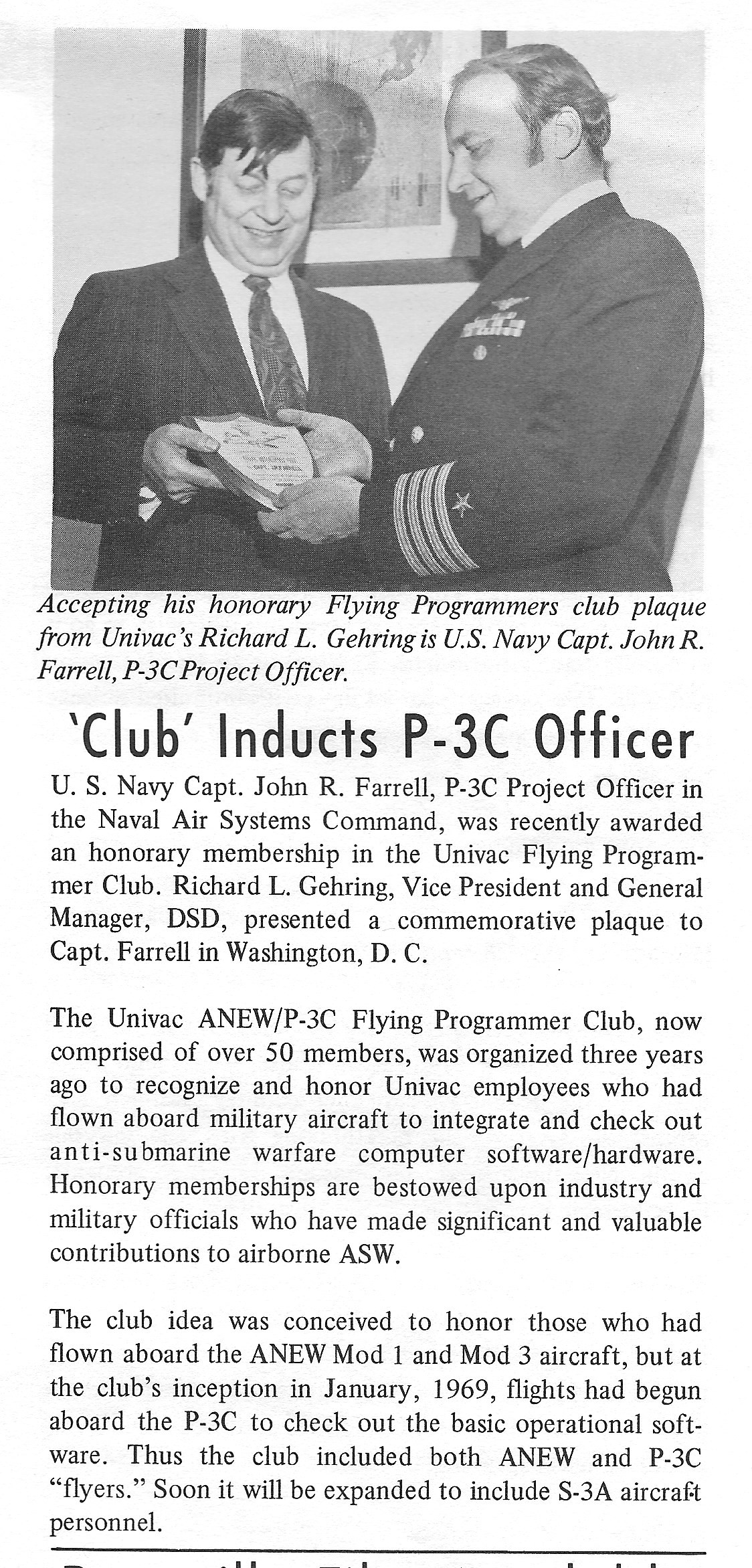 Copied from the UNIVAC-Sperry Rand News Vol. 1,
No. 2 Twin Cities Edition - February 29, 1972: "The
Univac ANEW/P3-C flying Programmer Club, now comprised of
over 50 members, was organized three years ago to recognize
and honor Univac employees who had flown aboard military
aircraft to integrate and check out anti-submarine warfare
computer software/hardware. Honorary memberships are
bestowed upon industry and military officials who have made
significant and valuable contributions to airborne ASW.
The club idea was conceived to honor those who had flown
aboard the ANEW Mod 1 and MOD 3 aircraft, but at the club's
inception in January, 1969, flights had begun aboard the
P-3C to check out the basic operational software. Thus the
club included both ANEW and P3C 'flyers'. Soon it will be
expanded to include S3A aircraft personnel."
Copied from the UNIVAC-Sperry Rand News Vol. 1,
No. 2 Twin Cities Edition - February 29, 1972: "The
Univac ANEW/P3-C flying Programmer Club, now comprised of
over 50 members, was organized three years ago to recognize
and honor Univac employees who had flown aboard military
aircraft to integrate and check out anti-submarine warfare
computer software/hardware. Honorary memberships are
bestowed upon industry and military officials who have made
significant and valuable contributions to airborne ASW.
The club idea was conceived to honor those who had flown
aboard the ANEW Mod 1 and MOD 3 aircraft, but at the club's
inception in January, 1969, flights had begun aboard the
P-3C to check out the basic operational software. Thus the
club included both ANEW and P3C 'flyers'. Soon it will be
expanded to include S3A aircraft personnel."
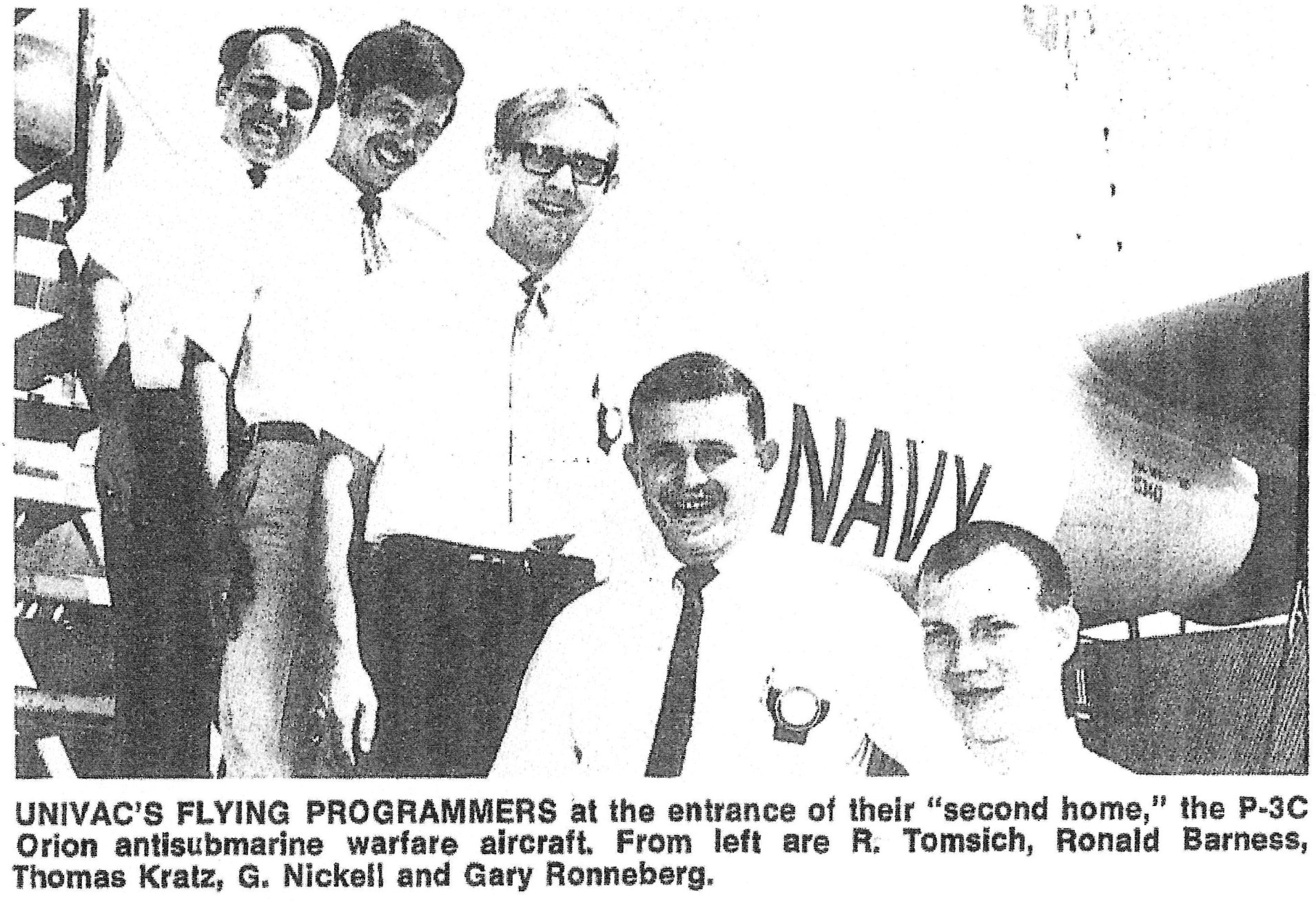 3.1 Programmers 'High in the Sky' for Univac
3.1 Programmers 'High in the Sky' for Univac
Transcribed by Lowell from a 1969 newspaper clipping submitted by Tom Kratz -
There’s a new breed of computer programmer winging his way around the United States these days. Although the designation isn’t official, the new occupational type is known as the "Flying Programmer” at the Univac Federal Systems Division. The new programmer got off the ground about seven years ago at Johnsville, PA, when the U.S. Navy started it’s a-NEW program, an effort aimed at developing a better anti-submarine warfare aircraft.
Since that time and the Navy’s acceptance of the P-3C Orion anti-submarine warfare aircraft, manufactured by the Lockheed-California Co., more than 30 men have joined the ranks of the semi-official Univac flying Programmers Club. “In those early days, several of the men chalked up a lot of flying hours,” a company spokesman said. “One of them, Gerry Butenhoff, now has nearly 1000 hours of flying time.” Two current members of the Flying Programmers team that take off from Lockheed facilities in Burbank, CA are Gerald Nickell and Ronald Tomsich.
Flying is not new to Nickell, 28, a native of Turtle Lake WI, and a Univac employee for two years. He spent four years in the Navy as an aviation electronics technician, and logged about 1500 hours on S-2Fs, a twin-engine antisubmarine warfare aircraft. But for Tomsich, 25, a native of Ely, MN, the P-3C is the first non-commercial flying venture. Nickell and Tomsich – they average about 25 hours of flying a month and draw company flight pay for it – work on testing and debugging new programs for the UNIVAC ASQ-114 while the P-3C aircraft is performing certain maneuvers, some at extremely low altitudes, over the Pacific Ocean.
Univac is building the ASQ-114 systems computer computer under a $13.6 million contract with the Naval Air Systems Command. The microelectronic computer which has problem-solving capabilities of large commercial machines but is many times smaller, is the primary data processor for the P-3C’s sensory, fire control, and supporting electronic subsystem.
Tomsich, a 1967 graduate of the University of Minnesota, and Nickell, who graduated the same year from River Falls State University (WI); helped write the programs or commands that went into the ASQ-114. “Their programs,” they said, “are primarily concerned with analyzing data gathered on submarine search missions.” “If any problems appear on the program, we’re there to locate and solve them,” Tomsich explained.
The programmers wear business suits on the flights. Other than that, they are treated as regular crew members and go through the same procedures—preflight briefing, de-briefings, etc. “Some of the flights are long – most of the time is spent standing. There are few opportunities to take a break,” Tomsich said. Even when the aircraft is on the ground, the programmers are aboard, testing their programs. When they’re not on the plane, they’re working in a special programming simulation laboratory at Lockheed facilities. “The time goes fast for us, but the wives aren’t too thrilled with the hours we put in,” Nickell said. A company spokesman put it another way: “It’s no joke when they say the aircraft is ‘their second home,’ because it does see more of them than their families.”
Both programmers, however, view their work as rewarding. “The reason,” Nickell said, “is that we can see the end results of our work.” "Most programmers,” he said, “work in a quiet office and never get to see the end result of their work, or the computer they’re working on.” However, the flights do take on an office-like routine when they’re flown daily. “But we had parachute drill one day and that was enough to snap me out of the office-routine thing,” Tomsich said. There’s nothing to it- as long as you’ve got your feet on something solid,” he smiles.
3.2 David M. Noyes
From 1969-1973 I was a programmer for Univac in Valencia, California working on the S-3A ASW aircraft development. As part of my work, I flew in a Lockheed P-3 aircraft which was equipped with S-3A avionics. We called it the flying test bed. It was essentially a hardware/software debug flight. My principal area of responsibility was the AYK-10 computer operating system--primarily the In Flight Performance Module. Please add me to the list of "Flying Programmers". Thank you, David M. Noyes Northfield, MN
There were several other "flying programmers" during the
S-3A development at Valencia, Ca. in the early 70s. Three
that I can specifically remember were Larry Christenson, Tim
Houlton, and Dick Chiracosta [I
might be misspelling his name]. Houlton was originally from
Wisconsin, [played football for the
Washington Redskins for one year,] worked on the P-3
in St Paul, transferred to California, and never came back
to the Midwest. Christenson was from Utah, worked on the P-3
program in St Paul, transferred to California and never came
back to the Midwest. Christenson was mentored by John
Spearing, one of several site managers at Valencia, and
later became a program manager. Chiricosta, whose first name was
really Dominic, was a west coast hire. Cheers! Dave Noyes
![]()
3.3 Jack Anderson and Lowell Benson 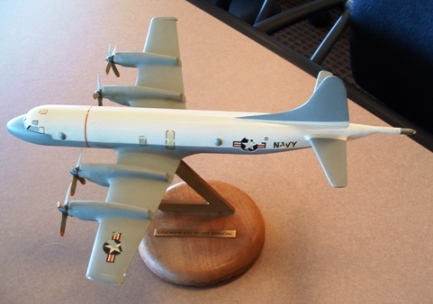
In 1967 the Navy flew a P-3C into Naval (reserve) Air Station at Wold Chamberlin Field in Minneapolis - Jack Anderson [Field Service engineer] and I [design/test engineer] got on board with the CP-901 S/N 1 then flew to the Naval Air Development Center (NADC) at Johnsville, PA for the first customer delivery. Jack and I installed the CP-901 into their computer center for ASW software development. Two decades later, we smiled while watching the P-3C in the 'Hunt for Red October' movie. We'd flown in a sub-hunter plane. This P-3C plan model was donated to the Legacy Committee by Jim Rapinac. [lab]
3.4 Quent Fabro
I was stationed in Patuxent River, MD for nine months and flew two to three times a week on the P-3 ANEW MOD 3 aircraft as Univac's software liaison. We demonstrated the system to Dr. Sebastian (DOD) and Cyrus Vance (He was Sec. of Defense then--later was Sec. of State) at Andrews AF base, Washington D.C. John Bezdicek should remember the aborted take-off and running off the runway that occurred shortly after the demo as we were preparing to go on a 10 hour mission shortly thereafter. Quent
3.5 Ron Handy
Hi, My name is Ron Handy. I flew with the A-NEW MOD 1 and Mod 3 aircraft out
of Pax River starting in ~1964. I was the
TechRep for General Dynamics, Electronic
Division and was responsible for the onboard
display systems. I was on the flight crew of
both aircraft for four years and flew with
Univac programmers Stan Sederstrom, Quent
Fabro and Oscar Lundbeck. Gerry Buttenhof
was Univac's hardware engineer.
Left the A-NEW crew in ~
1968..... Lots more stories to tell.
Ron Handy
3.6 Particia Myhre (nee Bailey)
 After ABCCC, we closed the doors to Corporate Square to make
the move to Plant 8 and my long career in the Maritime
Patrol Aircraft (MPA) area began. In 1990, I started in
software test for the CP-2044, which was the upgrade of the
software and capabilities for the P-3C aircraft. It was
through this program that I met Art Francis, Tom Rougier,
Hue White, and John Rachac, among many others. I was again
working for/with Bob Buth. From CP-2044, the natural
progression was to the Anti-Surface Warfare Improvement
Program (AIP) in 1994, which took CP-2044 and transformed it
with color displays and other hardware and software
upgrades. In the ensuing years, AIP has also made huge
changes which keep the P-3C MPA performing a vital role for
the U.S. Navy. I again worked for Burt Gunderson and it was
from his urging that I moved into an aircraft integration
role along with the software testing. I made many trips to
Greenville, SC, and Patuxent River, Naval Air Station (NAS)
to test the AIP aircraft.
After ABCCC, we closed the doors to Corporate Square to make
the move to Plant 8 and my long career in the Maritime
Patrol Aircraft (MPA) area began. In 1990, I started in
software test for the CP-2044, which was the upgrade of the
software and capabilities for the P-3C aircraft. It was
through this program that I met Art Francis, Tom Rougier,
Hue White, and John Rachac, among many others. I was again
working for/with Bob Buth. From CP-2044, the natural
progression was to the Anti-Surface Warfare Improvement
Program (AIP) in 1994, which took CP-2044 and transformed it
with color displays and other hardware and software
upgrades. In the ensuing years, AIP has also made huge
changes which keep the P-3C MPA performing a vital role for
the U.S. Navy. I again worked for Burt Gunderson and it was
from his urging that I moved into an aircraft integration
role along with the software testing. I made many trips to
Greenville, SC, and Patuxent River, Naval Air Station (NAS)
to test the AIP aircraft.
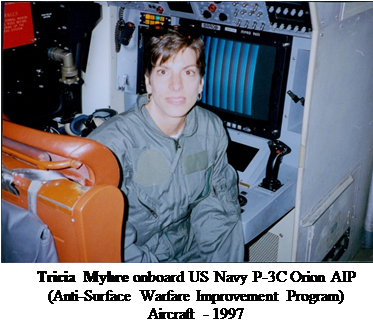 I was one of only a few people from Lockheed Martin – Eagan
(and the only female) who became flight qualified with the
Navy to allow me to fly along on test flights.
I was one of only a few people from Lockheed Martin – Eagan
(and the only female) who became flight qualified with the
Navy to allow me to fly along on test flights.
After CPF, I worked my first aircraft-related program, which was the
Airborne Battlefield Command & Control Center (ABCCC) program for
the Air Force, again performing software test. Our hardware and software
system was housed in an enclosed capsule that was loaded into the belly
of a C-130. I worked with Don Tredinnick under the management of Burt
Gunderson. Once more, we were making the trek to Plant 2 to work in
the capsule. Late nights in the warehouse area on the east end of Plant
2 could be spooky at times and more than once I about jumped out of
my skin when the guard poked his head inside the capsule to see how
things were going. I decided that working alone at Plant 2 under those
conditions was not a good thing for me or anyone for that matter and
more thought was put into having teams in place during the different
shifts. The highlight of ABCCC was being able to be on a couple of test
flights from the Air Force Reserve Base at the Minneapolis Airport.
More details of her career are in the People chapter,
http://vipclubmn.org/People5.html#PatMyhre.
3.7 John Enstad
I too was a flyer, beginning on the ANEW program as a fledgling programmer at Johnsville in 1967. My career summary
with details is a pdf file.
![]()
4. Special Programs
Tom Bayless wrote: “I have several candidates for the Flying Programmer Club although they didn't fly on ASW aircraft. Lauren Cady, John Bezdicek and Ken J. Nelson all flew debug missions on the Big Look Aircraft [a modified P-3.] Lauren and John flew on the RIVET JOINT aircraft along the Iron Curtain to test out the radar intercept system capable of measuring the characteristics of very closely guarded radars used by the Soviets when aircraft attempted to enter ‘their’ airspace. See Airborne System information.
Lauren ‘flew’ on the PHM-1 {Editor's note: See Hydrofoil Flying below for PHM-1 info} to test a radar intercept system used against surface ships and actually got the Soviets ‘fishing trawler’ to turn on certain surface radars that the US had not seen before. He told us later that the ride would not be for anyone with a weak stomach.”
I did think of one other person who flew with us on BIG LOOK, R. B. (Bob) Welsh, now deceased, flew as our systems engineer ensuring that our interfaces with the aircraft were all working and helping to troubleshoot other system problems. All of those flights were out of Point Mugu Naval Air Station and used PMR radars for targets. Tom
5. Hydrofoil Flying
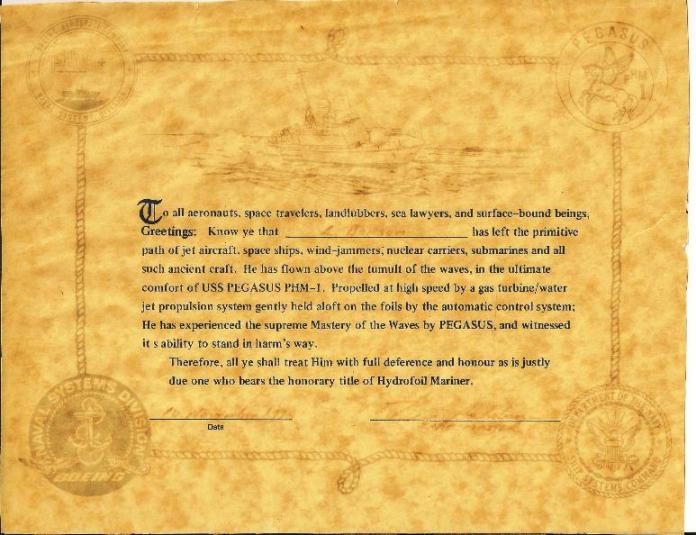 The US Navy gave Bob Herbster and Lowell Benson certificates [right] in recognition of their having
'flown above the tumult of the waves.' In the fall of 1975 the U.S. Navy was testing a small ships system aboard the USS Pegasus PHM-1.
The US Navy gave Bob Herbster and Lowell Benson certificates [right] in recognition of their having
'flown above the tumult of the waves.' In the fall of 1975 the U.S. Navy was testing a small ships system aboard the USS Pegasus PHM-1.
Each time they fired their anti-aircraft gun at a towed drone, the system went dead with a red light lit on the 1830B computer.
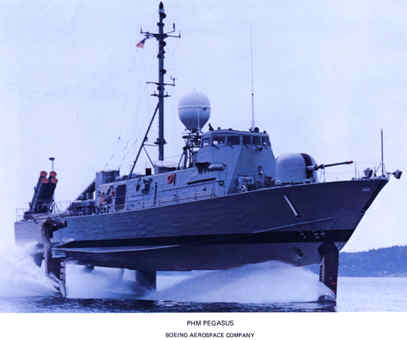 Lowell flew to Port Hueneme,
CA to ride the Pegasus with local field engineer, Bob Herbster. On the Pacific firing range they shot, the
system went dead, the computer's program fault and power fault light were both lit! I asked for a copy of their power
fault program - there was none. After half an hour I'd ginned up an elementary power fault program using machine
code, plugged it in from the maintenance console, and asked them to repeat the firing. They shot, the system blinked
and kept tracking the target. The power fault indicator was lit but not the program fault light. Bob and I then
determined that the power generator mounted on the fantail wasn't bolted down so the shock/vibration of the deck from the
gun firing caused the generator to slam sideways interrupting its output power. After bolting it down, they fired
again and the entire system operated as expected. I converted the simple power fault program from machine code to
mnemonics for their systems programmers.
Lowell flew to Port Hueneme,
CA to ride the Pegasus with local field engineer, Bob Herbster. On the Pacific firing range they shot, the
system went dead, the computer's program fault and power fault light were both lit! I asked for a copy of their power
fault program - there was none. After half an hour I'd ginned up an elementary power fault program using machine
code, plugged it in from the maintenance console, and asked them to repeat the firing. They shot, the system blinked
and kept tracking the target. The power fault indicator was lit but not the program fault light. Bob and I then
determined that the power generator mounted on the fantail wasn't bolted down so the shock/vibration of the deck from the
gun firing caused the generator to slam sideways interrupting its output power. After bolting it down, they fired
again and the entire system operated as expected. I converted the simple power fault program from machine code to
mnemonics for their systems programmers.
Bob and I received the honorary title of Hydrofoil Mariner [certificate] for our efforts plus overtime pay for our 17 hour day on the Pacific. [lab]
6. ABCCC by Larry Debelak
The ABCCC folks who rode combat missions in Desert Storm were Fred Svenson [Software Engineer] and Jim Rossman [Field Engineer.] The two newly minted EC-130E Capsules were delivered in August and completed OPEVAL just in time to be deployed and participate in the 15 January, 1991 start of Desert Storm. They were assigned Orbits on "Kill Boxes" to coordinate Attack Operations that destroyed the IRAQI forces. On one occasion when they were on board, an F-16 went down around Baghdad. The AC Commander made an impromptu decision to abort their orbit and fly to provide communications connectivity for the pilot to be rescued. A scenario that was to be repeated in Bosnia for the rescue of F-16 pilot Scott O' Grady and later the F-117 Pilot. In addition to the Missions, they were also in harms way as they wore gas masks and scrambled to shelters as the SCUD missiles targeted the base. We talked to them daily via Satellite Phone to monitor the status of their personal safety as well as the Systems performance. The Systems performed 1500 Mission hours without a failure. DCASMA presented UNISYS with a product award for the ABCCC and MATCALS performance in Desert Storm. Also, the ABCCC Program Office at ESC, Hanscom AFB was awarded a prestigious Procurement Program of the year.
During the Bosnia Conflict, ABCCC was the Component Commander and we provided support out of Aviano which was the longest TDY in USAF History [March 1992-December 1995. ] Andy Vitale [Field Engineer] and Bob DuBrall [Project Engineer] flew a half of dozen missions which checked aircraft in and out of Bosnia Combat missions. Bob was the Project Engineer for the newly Installed JTIDS Communications and Super Computer Intel Upgrades that facilitated the F-117 pilot rescue in 3 Hours versus the many days for Scott O'Grady. On one occasion due to heavy fog, the ABCCC Aircraft was diverted to spend the night in another Italian town. This resulted in a record 13.6 Hour Mission. Larry
In this Chapter
- Introduction
- Oscar Lundbeck by Ned Hunter
- Ensuing ASW Flyers from Tom Kratz, et al'
- Special Programs by Tom Bayless
- Hydrofoil Flying by Lowell Benson
- ABCCC by Larry Debelak
Chapter 20 edited
725//2025.